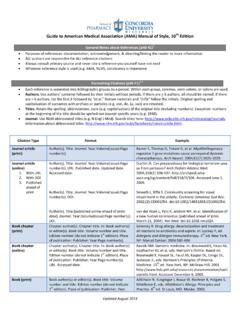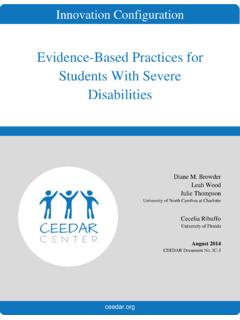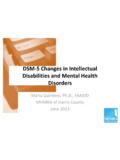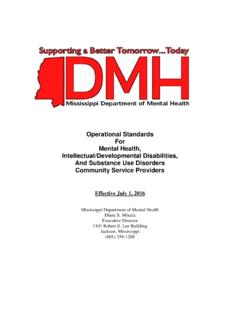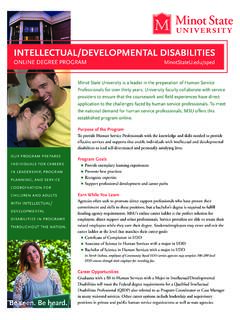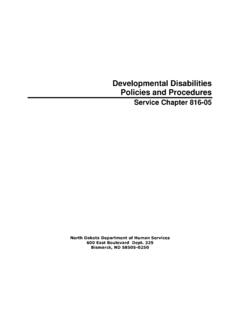Transcription of CAUSES of INTELLECTUAL and DEVELOPMENTAL DISABILITIES
1 CAUSES of INTELLECTUAL and DEVELOPMENTAL DISABILITIES : BIOLOGICAL CONSIDERATIONS and PREVENTION Updated January, 2015 . 2 Edward A. Polloway, Rosel H. Schewel Chair of Education Lynchburg College in Virginia J. David Smith, Professor Emeritus University of North Carolina, Greensboro Jacqueline Lubin. M. Ed., (candidate) Ministry of Education, St. Lucia Karian N. Antoine, M. Ed. Ministry of Education, St. Lucia Antonia Charles, M. Ed. Ministry of Education, St. Lucia January, 2015 Note: This chapter was updated for publication in a planned revision (eighth edition) of Beirne-Smith et al. s book on INTELLECTUAL DISABILITIES . However, that book was never published and so this revision is the property of the authors as a non-published (commercial) document.
2 Please address all inquiries to the senior author. 3 Overview This document is intended for educators and/or students with interest in INTELLECTUAL and DEVELOPMENTAL DISABILITIES . It discusses DISABILITIES under four main categories- genetic transmission, chromosomal abnormalities, cranial malformations, and other congenital factors. In each section, several examples of DISABILITIES are explained with emphasis on causation, diagnosis, and treatment. The table below summarizes the DISABILITIES discussed in this document. Category INTELLECTUAL / DEVELOPMENTAL DISABILITIES Genetic Transmission Dominant Transmission Neurofibromatosis Tuberous Sclerosis Huntington s Disorder Recessive Transmission Phenylketonuria (PKU) Galactosemia Sex-Linked Inheritance Lesch-Nyhan Syndrome Fragile X Chromosomal Abnormalities Autosomal Disorders Down Syndrome Prader-Willi Syndrome Williams Syndrome Cri du chat 4 Category INTELLECTUAL / DEVELOPMENTAL DISABILITIES Sex Chromosome Abnormalities Klinefelter Syndrome Turner Syndrome Cranial Malformations Microcephaly Hydrocephalus Other Congenital Factors Maternal Disorders Rubella (German Measles)
3 Rhesus Disease Substance Exposure Fetal Alcohol Spectrum Disorder Within this paper, pre-to-post natal concerns are discussed. Included is an explanation of strategies that can be used to prevent INTELLECTUAL and DEVELOPMENTAL DISABILITIES . These strategies range from those that can be implemented within the preconception stage to early childhood. There is an explicit description of ethical considerations that may arise in the effort to prevent INTELLECTUAL DISABILITIES . The paper concludes with final thoughts and a summary of key points. The information provided in this document can be used for general knowledge, as part of course content in special education classes and/or reference material. However, please note that all information is the property of the authors and so full credit must be given to authors whenever any material is used.
4 Please address all inquiries to the senior author. 5 Objectives After reading this chapter, the student should be able to: provide an overview of causation discuss the basic principles of genetics identify and discuss the major biological CAUSES of INTELLECTUAL and DEVELOPMENTAL DISABILITIES identify areas in which treatment implications are indicated discuss various ways that INTELLECTUAL disability can be prevented identify and discuss selected ethical issues facing the field The task of sorting out the many CAUSES of INTELLECTUAL disability is formidable. From the beginnings of the study of INTELLECTUAL disability in the earliest part of recorded history to the more advanced efforts in the 21st century, the search for causation has been challenging.
5 The goal of this chapter is to provide a foundation for understanding the complexities in the CAUSES of INTELLECTUAL and DEVELOPMENTAL DISABILITIES . CAUSES of INTELLECTUAL and DEVELOPMENTAL DISABILITIES have traditionally been divided into two categories: biological (or physiological) and environmental (or psychological and sociological). Such a taxonomic grouping of CAUSES might be thought to create clear dichotomy of specific CAUSES . However, factors from both of these domains are often relevant in individual cases of these DISABILITIES . Although hundreds of specific factors have been identified as causative agents of INTELLECTUAL disability, the number of cases of with unknown CAUSES are still as large as those that are known and specifiable; that is, in 50% or more of cases can a specific cause ( , biological 6 factor) be identified (Dykens, Hodapp & Finucone, 2000; van Karnebeek et al.)
6 , 2005). A key problem is that CAUSES may be undetermined for the many persons identified as having a mild disability (which constitute perhaps 60% of persons with INTELLECTUAL DISABILITIES ; PCPID, 2007). A traditional perspective of causation is the two-group model that includes a group with organic ( , specific biological) CAUSES and a second group presumed to be socio-cultural or, historically cultural familial (Spinath, Harlaar, Ronald, & Plomin, 2004). The first group consists of known and specifiable biological CAUSES that often classified as pathological and/or clinical. Although such CAUSES may result in INTELLECTUAL DISABILITIES at all levels, most attention in the past was drawn to their etiology of more significant DISABILITIES .
7 Biological pathology can be identified in from 60% to 75% of cases IQs falling below 50 (McLaren & Bryson, 1987) or higher (Heikura et al., 2005). But the traditional association of a single, organic cause just with significant DISABILITIES is too simplistic; many individuals with high incidence DISABILITIES ( , mild INTELLECTUAL DISABILITIES ) may also be affected because of physiological factors. The other traditional assumption that mild DISABILITIES are the result of multiple, unspecifiable environmental events has also given way to the fact that this is only a broad brush distinction (Moser, 2000) and thus estimates over the past two decades have concluded: up to 40% of all cases of mild DISABILITIES may have a specific identifiable cause (Harris, 2006; McLaren & Bryson, 1987); 10-50% of cases of mild INTELLECTUAL DISABILITIES are related to genetic etiologies (Dykens et al.)
8 , 2000); and only 33% are unknown (Heikura et al. 2005). Further the assumption that sociocultural factors are all environmentally-based has been challenged by studies of possible genetic influence ( , Spinath et al., 2004). Clearly these data are influenced significantly by state prevalence rates (see USDOE, 2007), in that states with high rates of identified INTELLECTUAL DISABILITIES (for ages 6-17) ( , 7 West Virginia, ; Wyoming, ) are likely to have a larger number of students with mild DISABILITIES and an associated lower percentage of identified biological CAUSES than would a state with a lower prevalence ( , New Jersey, %; California, %) (see Polloway, Lubin, Smith, & Patton, 2008). Despite these data, it is nevertheless important to recognize that many individuals with mild DISABILITIES are also affected by genetic and other biological CAUSES and that psychological and social influences are equally important in cases of severe disability.
9 Finally, there is increasing confidence that the cause of virtually all cases of INTELLECTUAL DISABILITIES may become identifiable (Moser, 2000). Given this confounding complexity, why should educators, psychologists, and other behavioral scientists spend time studying causation of INTELLECTUAL DISABILITIES ? Kolstoe (1972), in his classic work, noted that familiarity with these causative factors facilitates multidisciplinary communication, is an essential element of professionalism, and is important in enabling professionals to make accurate information available to parents. Clearly, parents have the right to know information that may be related to inherited forms of INTELLECTUAL DISABILITIES and also should be well-informed about preventable environmental hazards that might otherwise be associated with DISABILITIES (Percy, 2007).
10 Furthermore, in most situations, etiological information from educators and childcare professionals can contribute to a more accurate diagnosis. The role of teachers, for example, may include monitoring the effects of ongoing or progressive disorders that may hinder daily performance, preventing future occurrences through parent counseling, or facilitating immediate change ( , intervention in a case of child abuse). Finally, research is beginning to identify certain educational and psychological intervention strategies that may be etiology-specific. Therefore, an understanding of causation may ultimately lead to alternative approaches to curriculum and instruction ( , Powell, 8 Haughton, & Douglas, 1997; Hodapp, 1997). Hodapp (1997) suggested that the field has generated conflicting views of the relationship between etiology and behavior; on the one hand, the position is that, for example, specific genetic disorders have no specific effects on behavior while an alternative is that genetic disorders are regularly and consistently associated with a distinctive behavioral pattern.

